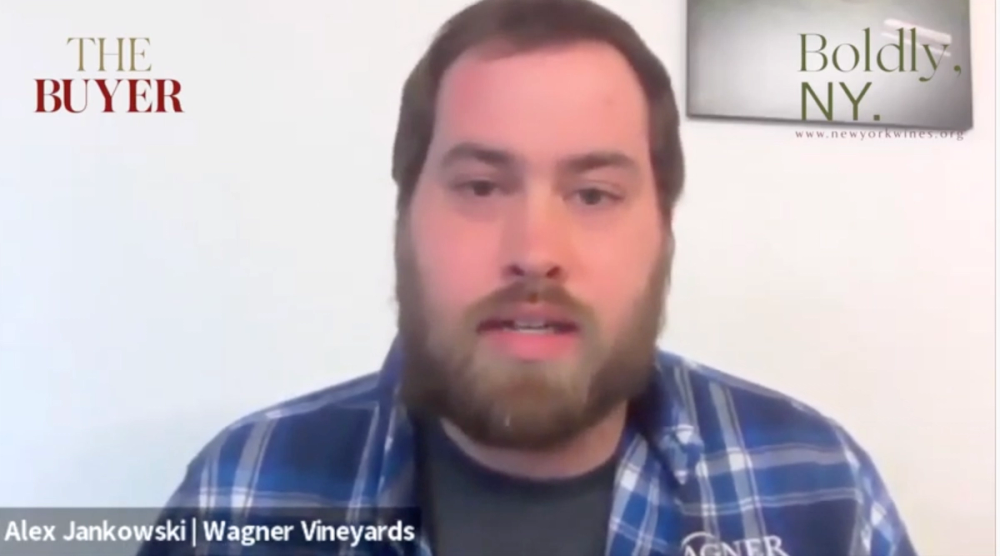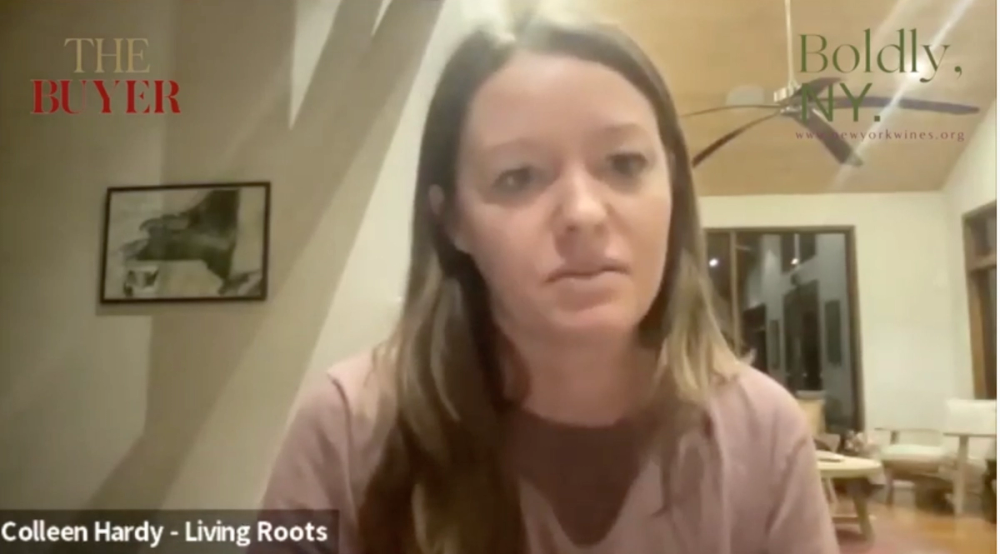If you do not know the wines of New York State very well here’s a quick overview of what UK buyers think have the most to offer the UK market. Click here to read Part 1 in our New York Pitch project.
(To watch the full video of our New York debate and pitch project click the link below)
With the wines tasted and the pitches done it was time for the UK buyers and New York State producers to come together to discuss the main themes to come out of the event. A chance for producers to showcase what they and the state can do, and an opportunity for busy buyers to get a clear, concise insight into what sort of styles of wine might be right for them and their import needs.
The buyers taking part in the live session were:
Corney & Barrow: Rebecca Palmer
Wanderlust Wine: Richard Ellison
Propeller: Corinne O’Connor winemaker
Graft Wine: Miranda Fong
Fine Wines Direct UK: Bastien Martinole
The New York State Producers taking part included:
Buttonwood Grove Winery: Carmela Barbagallo
Lieb Cellars: Aimee Lasseigne New
Ravines Wine Cellars: Morten Hallgren
Mazza Chautauqua Cellars: Mario Mazza
Hound’s Tree Wines: Alexander Rosanelli
Wagner Vineyards Estate Winery: Alex Jankowski
Four Maples: Erwin Kalmar
Brotherhood Winery: Philip Dunsmore
Riesling is the backbone, the DNA if you like, of so much of what New York State produces. But it would be hard to pigeon hole the exact New York style of Riesling as there are so many to choose from, many of which were showcased during our debate.
The trend, however, is very much towards drier styles, says Morten Hallgren, owner of Ravines Wine Cellars in the Finger Lakes, which is where it has chosen to be from when it first started out in 2000. It is also what the markets it works in both in the US and overseas (Denmark and Japan) are looking for. Particularly for the more aged styles that Ravines specialises in.
He says you can always identify a Finger Lakes Riesling by its “solid backbone of acidity” backed up by “crystalline bright fruits and floral aromas” and the winemakers biggest challenge is dealing with phenolics and ripeness levels that can be managed with levels of skin contact.

Alex Jankowski of Wagner Vineyards says he is pleased to see the return in demand for dry Rieslings
Alex Jankowski at Wagner Vineyards says there has been a clear switch away from sweet, semi sweet styles to a demand for dry Rieslings. Which is reflected in its own production. In 2018 it made 662 cases of its dry Riesling style, in 2019 that went up to 1,300 cases and in 2020 that was 3,000 cases. “That is something we have always pushed,” he adds. “Dry Riesling is an extremely versatile wine and it does not need to be laden with residual sugar to be an enjoyable wine. It has that nice edge of having acidity, whilst still maintaining balance, and lemon, lime characteristics as well.”
Mario Mazza at Mazza Chautauqua Cellars says there is certainly more interest within the US for more bottle aged, complex Rieslings from New York, but it is still more of a niche part of the market.
Riesling potential
The bottled aged Rieslings certainly hit the mark with the UK buyers who felt that could be a real point of difference for the region.
The UK wine market after all, says Richard Ellison at Wanderlust Wine, has been built on the back of drinking German Rieslings. “It’s rare to find someone who has an aged Riesling as it is guzzled long before it has fully matured,” he says. “If It’s good then it will be popular.”
Where bottle aged Rieslings really come into their own is with restaurants that have a bigger list and are looking to specialise and offer a wider range that can be used with pairing menus, says Fong.
“I think it is also about price,” adds Rebeca Palmer at Corney & Barrow. Just having an aged Riesling does not mean you need to be charging a lot more for it. “If you are releasing wines to market a bit later that are coming into focus then good on you if you can finance that then you will find a ready and willing audience for you, but if you are talking about loading value on to it then that will detract from your volume.”
They would also welcome different ageing and fermenting techniques with Riesling be it with foudres or barrels or eggs.

Colleen Hardy, part of the Australian winemaking family, is also making wine in New York State
“Customers are very open to different styles of Riesling,” says Graft’s Miranda Fong. “It is one of those beautiful varieties that does not ever lie. It’s so honest. It shows everything that is done to it. If there is ever a variety to do something like that with then it’s Riesling.”
Palmer was not so sure: “Barrel ferment is not really what our customers want,” she says, “and we work across a wide range and we have not seen any demand for it.” Instead if you have a “very fresh and clean style” of Riesling then you are better sticking with that as Riesling “is not an easy sell” at the best of times. “It is more of a push than a pull.”
Fong, though, was quick to stress that its “bread and butter” sales of Riesling were for the classic styles.
Elly Owen at The Old Garage also felt producers would be best served to concentrate more on the classic Riesling styles and felt they would “sit against some of the Australian Riesling as a New World alternative – the Ravines especially”.
Corinne O’Connor at Propeller was particularly interested to see the number of hybrid styles being used across New York State which very much chimes with what she is seeing in the UK, not just with its winemakers and producers, but also demand from independent wine merchants looking to stock environmental and sustainable wines.
Rosé’s potential
Rosé is a small but growing area of the state too, with wineries looking to make use of the wide variety of grapes grown in the region. Mazza Chautauqua Cellars, for example, uses Chambourcin to give its rosé fresh fruit and acidity from a robust variety that is lower in tannins that it knows works well in Australia. But there are also rosés being made from Merlot and Cabernet Franc.
Production is still small compared to the region’s hero varieties and styles, but it is one to watch, says Mario Mazza. Mazza Chautauqua, for example, is now making over 7,000 cases of rosé across its various ranges. “It continues to grow from what was only a nascent programme about seven or eight years ago,” he adds.
Carmela Barbagallo at Buttonwood Grove agrees: “We are seeing rosé as a growing category in the Finger Lakes, especially in the last four or five years.”
Focus on lower alcohols
(Hound’s Tree Wines winemaker Alexander Rosanelli on New York State’s cool climate and lower alcohol wines)
One of the trends that emerged from the tasting and producer pitches was how many wines sat between 11.5%-13.5% alcohol levels, which compared to their peers in California certainly ticks the box for those buyers looking for lower abvs.
Alexander Rosanelli, winemaker at Hound’s Tree Wines in Long Island says it is not something that he particularly looks to do, but producing lower abv wines very much goes with the territory, the climate and the grapes it is producing. Which is thanks to its “maritime climate and relatively cool and long growing season” and the fact it is not having to cope with large diurnal changes in day and night temperatures or vin that you see in California. As a result you get more retained acidity and thanks to the long growing season “you get that full physiological maturity to the fruit”. “You are seeing ripe varietal characters and ripe flavours in the fruit while retaining that bright acidity and low alcohol.”
Colleen Hardy at Living Roots Wine & Co in the Finger Lakes says wineries in New York State are so well positioned to tap into the drive toward lower and no alcohol wines “as it is not that difficult to do” thanks to its cool climate. Its Sessions range is between 8-10% abv.
Jankowski at Wagner Vineyards says it works hard on its Scott Henry trellising systems in order to give its vines as much sun exposure as possible and winemakers have been able to learn a lot, in particular, from how they have handled Cabernet Franc over the last 10 years in order to maximise fruit potential and ripeness and get away from any green characteristics. “I am really excited to see how Cab Franc can evolve here.”
That’s a major plus, says Ellison at Wanderlust Wines, and will help the region throw off any of the perceptions that it is making “green” red wines. “Producers are really cracking it now in terms of having fully ripe and delicious reds at still low to moderate alcohol levels which is really what is everyone is looking for.”
He would now urge them to hold back on the oak treatments and let the fruit do the talking.
Rebecca Palmer agrees and says being able to achieve that “level of fruit purity and physiological ripeness” is really attractive “so why bang oak on there”.
She adds: “It’s a lot about purity now in the UK market and without wanting to sound didactic I would bear that in mind.”
- You can read Part 1 of our report here.
- For any more information on New York Wine & Grape Foundation and its wines go to its website here.































